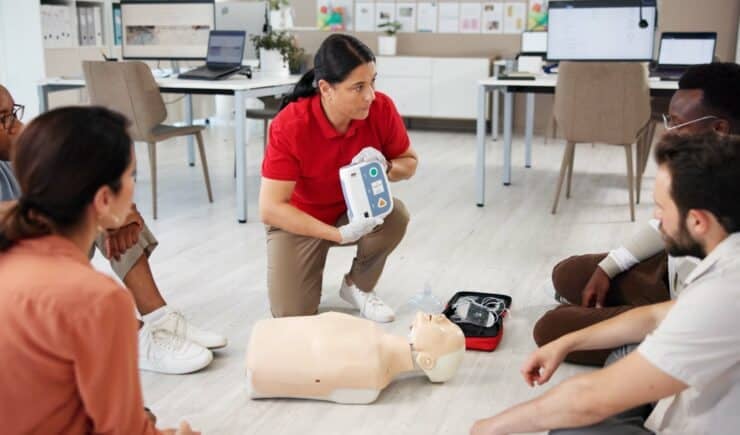There’s increasing pressure to convert all instructor-led training (ILT) to virtual formats. While virtual training certainly has its place, the rush to convert everything to online delivery often overlooks the unique advantages of in-person instruction and the specific contexts where it remains the superior choice. Organizations need to consider a more nuanced approach to training delivery to achieve optimal learning outcomes.
The False Economy of Universal Virtual Conversion
While converting ILT to virtual formats might seem cost-effective at first glance, this approach often creates hidden costs that can significantly impact both budget and learning effectiveness. The development time required to create engaging virtual materials typically exceeds that of traditional ILT materials, as instructional designers must account for different attention spans and engagement patterns in the virtual environment. Production costs can also escalate quickly when accounting for the technology and expertise needed to deliver high-quality virtual training.
Moreover, virtual formats often require extended training time to cover the same material effectively, as instructors must navigate technical challenges and implement additional engagement strategies. When virtual formats prove insufficient for complex topics, organizations frequently find themselves investing in supplementary training sessions or facing productivity losses due to reduced knowledge retention. These hidden costs can quickly erode any perceived savings from the initial conversion to virtual delivery.
When Physical Presence Matters
Some training scenarios fundamentally benefit from in-person instruction, and attempting to replicate these experiences virtually can compromise learning outcomes. Complex technical skills, for instance, often require hands-on demonstration and practice with immediate instructor feedback. When teaching employees how to operate specialized equipment or perform intricate procedures, the ability to observe, correct, and guide in real-time becomes invaluable.
High-stakes communication training presents another compelling case for in-person delivery. Leadership development programs, sales training, and conflict resolution workshops rely heavily on reading and responding to subtle non-verbal cues – elements that often get lost in virtual translation. The physical presence of an instructor allows for nuanced demonstrations of body language, tone, and presence that participants can observe and practice in a controlled environment.
Team-based learning scenarios particularly suffer in virtual environments. Cross-functional collaboration workshops and strategy development sessions thrive on the energy and spontaneous interactions that naturally occur in physical spaces. The subtle dynamics of team formation, the ability to read room energy, and the organic development of trust and rapport all happen more effectively in person.
Our work with Siemens Healthineers revealed how important in-person ILT is for some types of training. You can read more in our case study.
The Engagement Advantage
While virtual training platforms struggle with maintaining consistent engagement, well-designed ILT creates natural engagement through human connection and physical presence. The immediate human connection in a classroom setting facilitates learning in ways that virtual environments struggle to replicate. Instructors can read micro-expressions, adjust their approach based on subtle cues, and create an environment where spontaneous discussions emerge naturally.
The physical classroom also provides a dedicated learning environment that minimizes the distractions inherent in virtual settings. Participants aren’t tempted by email notifications or household interruptions, and the shared physical space creates a natural accountability that keeps learners focused and engaged. This environment allows for a dynamic learning flow where the pace can be adjusted organically based on group needs and understanding.
Time Efficiency in Practice
The apparent time savings of virtual training often dissolve when considering the full scope of delivery requirements. Virtual sessions frequently require additional time for technical setup, troubleshooting connection issues, and managing digital tools and platforms. Instructors must build in extra time to establish virtual rapport and implement engagement strategies that happen naturally in person.
In contrast, ILT allows for immediate startup and engagement, with participants fully present from the moment they enter the room. The natural group dynamics of in-person training facilitate faster problem resolution and more efficient knowledge transfer. Questions get answered more quickly, misunderstandings are identified and addressed immediately, and the learning pace can be adjusted smoothly without technological constraints.
The Technology Balance
Modern ILT isn’t about avoiding technology – it’s about integrating it strategically to enhance the learning experience while maintaining the benefits of in-person instruction. Today’s successful training programs often employ a thoughtful blended learning approach where technology supports rather than replaces face-to-face interaction.
Digital platforms can deliver pre-work and theoretical content before in-person sessions, allowing valuable classroom time to focus on practice, application, and complex skill development. Post-session digital reinforcement and practice tools help cement learning, while sophisticated training management systems track performance and optimize resource allocation across both physical and virtual delivery methods.
Our partner, Roche Diagnostics, found that balance of technology and in-person training. You can read more in our case study.
Making the Right Choice
Rather than defaulting to virtual conversion, organizations need to evaluate their training needs through multiple lenses. Learning objectives should drive delivery decisions – considering not just what needs to be learned, but how critical the skills are and what level of proficiency is required. The complexity of the material, the importance of immediate feedback, and the role of social learning all impact the effectiveness of different delivery methods.
Audience needs play a crucial role in this decision-making process. While some learners thrive in virtual environments, others strongly benefit from the structure and interaction of in-person training. Technical comfort levels, learning preferences, and the importance of peer learning should all factor into delivery choices.
The Future Is Hybrid
The most successful organizations are moving away from all-or-nothing approaches to training delivery. Instead, they’re developing sophisticated training ecosystems that maintain multiple delivery options, allowing them to match the right approach to each learning need. This flexibility enables them to deliver critical skills training through the most effective channel while optimizing resources and maintaining high engagement levels.
Modern training management systems make it possible to efficiently coordinate and deliver multiple training formats while tracking results across platforms. This technology allows organizations to make data-driven decisions about delivery methods while ensuring consistent quality across all training modalities.
Conclusion
While virtual training has its place in the modern learning ecosystem, wholesale conversion of ILT to virtual formats isn’t always the best solution. The key to successful training lies not in following trends but in making strategic choices based on learning objectives, audience needs, and desired outcomes. Modern training management systems allow organizations to efficiently deliver and manage multiple training formats, ensuring they can choose the right delivery method for each learning need.
By maintaining and modernizing ILT capabilities alongside virtual options, organizations can ensure they have the full range of tools needed to develop their workforce effectively. The future of corporate training isn’t about choosing one delivery method over another – it’s about having the flexibility to choose the right approach for each specific learning need.





